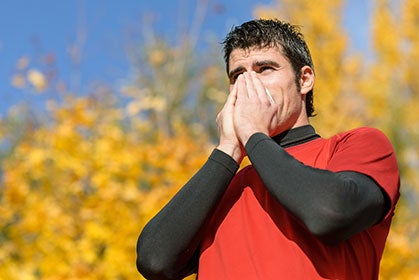Allergic to Running—Literally

Ask the Dietitian: Food-dependent exercise-induced anaphylaxis
Photo by BigStockPhoto
I have a rare but challenging problem: I am allergic to running! I was diagnosed with food-dependent exercise-induced anaphylaxis 10 years ago. When I eat certain foods and go for a run up to six hours after I eat, I have an anaphylactic reaction. I can eat these foods any time post run and have no reaction. This has really limited my race and training fuel options. Any thoughts on what I should eat during a run? I am allergic to grapes, raisins, wine, currents, rice, onions, fennel, cranberries, celery and all nuts. I am at a loss … it has come down to eating goldfish crackers and gumdrops and lots of trail “runs”—as in the loose kind!
-Katy Van Nostrand, Carbondale, CO
The first diagnosed case of food-dependent exercise-induced anaphylaxis (FDEIA) came in 1979. The subject, a marathon runner, experienced anaphylactic symptoms on two separate occasions that were caused by eating shellfish and triggered while running.
FDEIA is often left undiagnosed because it is so rare. According to a 2006 update in the European Annals of Allergy and Clinical Immunology, exercise-induced anaphylaxis is defined as the onset of allergic symptoms during or immediately after exercise. The clinical signs can be anything from hives, to respiratory and gastrointestinal irregularity to anaphylactic shock. FDEIA occurs when food intake, followed by exercise, elicits these allergic symptoms. Without exercise, there is no allergic response. Wheat and shellfish are the most potent foods shown to bring about a reaction, but a variety of foods including milk, nuts, seeds, fruits and vegetables have been reported.
Because this syndrome is so uncommon and the onset of attack is very specific to each individual, it is difficult to design a one-size-fits-all meal plan for those with FDEIA. As with a food allergy, FDEIA is diagnosed based on interview, skin and biological tests with a broad range of foods and additives. Carefully monitored exercise challenges performed with and without prior ingestion of food are often also required.
The standard recommendation for FDEIA is to exercise first thing in the morning on an empty stomach. However, for a long-distance runner looking to sustain several hours of running on the trail, this solution may prove impractical.
Given your specific allergies, consider natural, easy-to-digest foods such as bananas and sweet potatoes. Tortillas, pretzels and low-fiber cereals void of nuts are all portable options. If solid food still causes an upset stomach, consider experimenting with liquid calories. There is a plethora of sports drinks and mixes available or, better yet, make your own at home.
Most importantly, know what triggers your attack, be it a certain food, pace or temperature—and know how to treat episodes. Stick with the foods that you know are safe, even if that means goldfish crackers and gumdrops. You can focus on eating a balanced meal complete with lean protein, complex carbohydrates and healthy fats after your run.
If you are unsure about what will provoke an attack, run with a friend who is aware of FDEIA, understands the nature of an episode and knows the proper use of emergency epinephrine, if appropriate. The best thing you can do is to recognize the early warning signs and symptoms of anaphylaxis and take the necessary steps to stop its progression.
Editors’ Note: This is an installment in our online Ask the Dietitian column with Maria Dalzot, MS, RD, CDN and an avid trail runner. You can visit her blog at www.mariadalzotrd.com and submit your nutrition questions to nutrition@trailrunnermag.com.